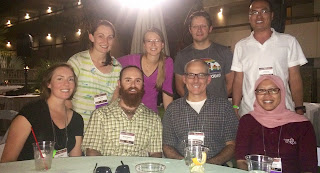Many of my students and colleagues and I just returned from the 2014 Southern California Earthquake Center meeting. It was really great: so much energy, so many old and new friends and colleagues. It is a very strong community with a world-leading emphasis on earthquake system science. I am on the Planning Committee and was very engaged many aspects of the meeting.
Here is a fun picture from the meeting:
I flew to Palm Springs for the meeting and on the flight home, I had a nice view of the San Andreas Fault zone in the Indio Hills just to the east of Palm Springs and the meeting location. Here are two pictures:
The main fault trace cuts diagonally across the middle of the upper view. Two large scale right lateral offsets are evident along the fault. On the right side of the lower image, secondary (normal?) faults cut the uplifted alluvial fan units.
Along the San Andreas Fault in this area the the B4 laser scan data were collected by the Ohio State University, the National Center for Airborne Laser Mapping, USGS, and UNAVCO. The data are available on line at OpenTopography. Here is a screen capture of the hillshade in google earth:
And, here is the kmz file for that area of the hillshade of the DEM I calculated at OpenTopo.





No comments:
Post a Comment
Note: Only a member of this blog may post a comment.